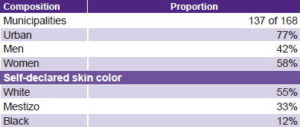Beatriz Marcheco: In 2007, a study was carried out in two Cuban provinces to determine risk factors for dementia in older adults. Empirically, researchers noticed that more people with white skin color were being seen in health services for illnesses such as Alzheimer disease. So the question posed was: does the African component in our ancestry confer some degree of protection against these diseases? We designed a genetic investigation to find out.
As a result, we discovered several important things: first, skin color did not reflect the actual genetic ancestry of patients. In fact, all of the 531 patients studied were of mixed ancestry: absolutely all shared African-origin and European-origin genes.
Often, skin color was associated with the proportion of one or the other, but certainly it was not synonymous: for example, we found people whose skin was very white who had an appreciable number of African genes. And vice-versa, people identified as black or mestizo (a range of colors, neither black nor white), with a significant proportion of European genes. (These are the three categories of skin color used by our national census.)
Second, we found that the more African genes a person had in their makeup, the more probable it was that they carried a risk variant of the Apoliporotein E gene (transporting cholesterol), hence making them more susceptible to certain types of cardiovascular disease and dementias, too. Just the opposite of what had been posited by taking into account skin color alone. So it became clear, in turn, that other factors, perhaps social determinants, were at play influencing people’s decision to seek out medical attention.
Our research also showed once again how subjective is classification of skin color itself, interpreted differently by the patients, and by the social workers and family doctors who described their patients.
These findings led us to more questions about the genetic ancestry of the Cuban population as a whole, and about the biological evidence and social relationships that alternately demystify and define the concept of “race.”
MEDICC Review: So the next phase was research to determine more precisely the genetic origins of today’s Cubans. I understand this was also the first study that contemplated a sample of an entire nation’s population.
Beatriz Marcheco: Yes, absolutely. We studied persons aged 18 years and older, in proportions demographically representative of the whole country by sex, age, skin color, and geographic residence (both by province and urban/rural setting). We ended up with a sample of 1019 persons aged 18 to 95 years, residing in 137 of Cuba’s 168 municipalities; 77% were living in urban areas, approximating the proportion in the census; and 58% were women, who were the ones most likely at home when we went house-to-house.
We had three main objectives: First, we aimed to classify the sample by skin color, self-reported and by specially trained health professionals, as well as using a reflectometer to measure melanin pigmentation levels in persons identified as white, black or mestizo. Second, we used chromosomes and mitochondrial DNA to determine the admixture of African-, European-, and Native American-origin genes in our population. And finally, we looked at the relation between skin color (self-reported and researcher-reported); melanin index; and the proportional ancestral gene mix.
Study population

MEDICC Review: Let’s take skin color first….
Beatriz Marcheco: This was quite interesting. First, the subjective nature of skin color definition was quite apparent in our results. You can see this in the way the melanin-index levels overlap through all three skin color categories observed by the human eye, from white to black. For example of the 301 persons who declared themselves mestizo, over half had the same melanin index as those who declared themselves white.
Study population

aIncludes residents in Cuban provinces except Havana and some municipalities of Pinar del Río Province, those studied when reflectometer unavailable
bMI measured with reflectometer on inside upper arm
So people declare the color they understand themselves to be. Take two people with the same levels of pigmentation (melanin index) in two different parts of the country: we found, for example, that in Villa Clara Province, a person would identify as mestizo, while in Santiago de Cuba, where more of the population is darker-skinned, a person with the same pigmentation would identify as white. This has much to do with the range of skin colors in one or another territory, and with other social factors as well. But scientifically speaking, these two people have the same skin color. In the earlier study in two provinces, we also found researchers identified the same people differently: family doctors as a whole tended to classify them as darker, while social workers tended to classify them as lighter. (It would be interesting to study the predominant self-identified skin colors of these two groups, since it has been shown that people identify more precisely skin tones closer to their own). In the national study, researchers’ classifications more closely matched self-declared skin color.
We found more or less the same proportion of black skin color as the census, but more people declaring themselves mestizo and fewer white. We need to remember that the census relies on one family member declaring for the rest. So this calls into question the usefulness of skin color—especially by itself, unrelated to other factors—as a variable in biological studies related to health and disease. Comparison with our genetic findings points this out even more clearly.
MEDICC Review: Which brings us to the study’s results concerning the genetic identity of the Cuban population. What did you discover?
Beatriz Marcheco: First, we reconfirmed that absolutely all Cubans are of mixed ancestry. It was Nicolas Guillén, Cuba’s National Poet, who told us that we all carried a bit of Africa in our veins….hence the popular saying “if not from Congo, then from Carabalí”….and genetically-speaking, he was absolutely right.
We found 72% of our genes are European-descendent, 20% African, and most surprising of all, 8% Native American. Why surprising? Because until now, we had thought that the indigenous component of our genetic patrimony had been lost with the virtual extermination of the Taínos and Siboneys (Guanahatabeys) within the first 50 years of the Spanish conquest of the island—from some 100,000 to barely 5,000 by 1556. But no, we conserve this heritage. And we conserve it through the maternal line. Since only the ovulo, not the sperm, contains cytoplasm, we can use this to distinguish our “Eve,” or original mother. We found that for 38.8% of our population, this “Eve” was African; for 34.5%, Native American; and for only 26.7%, European.
Conversely, by using the Y chromosome in men, we found that 81.8% of Cubans are descendants of European fathers, 17.7% of African fathers and 0.5% of indigenous fathers (the latter discovered in the Caribbean for the first time, two men who are probably Taíno descendents).
These findings reflect Cuba’s history: that is, the relations of power between the European men on the one hand (who constituted 60%–85% of Spanish immigrants), and both the indigenous and African women on the other, beginning in the late 15th century and continuing through the 19th century. We need to continue studying, to find out more about how the indigenous peoples contributed to our gene pool today…how many Tainos, how many Siboneys; more precisely which and how many African ethnic groups, and from where on the continent they were captured and brought to Cuba as slaves (their numbers estimated at between 700,000 and 1.3 million). We should also study later migrations that have contributed to today’s Cuba through various generations.
We recently approached Cuban investigators participating in UNESCO’s Slave Route Project, proposing we work with other countries to jointly construct the region’s genetic patrimony—a study we hope will come to fruition.
MEDICC Review: And what did you find when you compared genetic ancestry to skin color in the Cuban population? And what are the implications of your results for public health?
Beatriz Marcheco: We found that from the biological standpoint, ancestry has more to say than skin color. This is important because skin color, however interpreted, is visible; and genetic composition is not. It depends on our ability to do genetic testing, which we have in Cuba thanks to the National Medical Genetics Program.
People with the same ancestral genes have different skin colors. We saw this among the three women who participated in our study: our blonde colleague had significantly more African-descendent genes than either of the other two researchers, who were darker-skinned—including myself. Thus, we have to take care when associating skin color with certain diseases, for example.
Our study opens up a new, informative line of research: genetic ancestry and its relation to protection or predisposition regarding certain illnesses. Even in such genetic studies, using case and control groups, we have to correct for stratification of the Cuban population, that is, the very wide variety of genetic admixtures. This also applies to regions of the country, admixtures differing from one province to the next. For example, more Native American ancestry is found in the provinces of Holguín and Granma. The great heterogeneity in the distribution of genetic components in Cuba implies a need for statistical methods to correct for this, or we will arrive at the wrong conclusions for our patients and population health in general.

E. Añé
At the same time, we have to keep in mind that genes themselves are usually not the only determining factor in health and illness: they are one factor, combined with the environment in which we live, including the just as critical social determinants of health.
Since in our study, in addition to skin color, we recorded various other demographics, as well as educational level and behavioral risk factors for chronic non-communicable diseases, further research can determinate association of these factors among themselves and with genetic ancestry.
MEDICC Review: This study obviously has broader implications. How would you describe them?
Archeology, anthropology, sociology, history…all have studied the evolution of human populations. Now DNA confirms the historical record. In our case, this is a record of exploitation, extermination, slavery and marginalization that have left a legacy of poverty and even ill-health long after the original damage was done. There is also a cultural inheritance: to overcome discrimination, we have to do more than have the political will or change the laws, but rather transform the horizons and thinking of a whole society, which can’t be accomplished in one or two generations.
But we have made a start. And the fact—now proven—that all Cubans carry the DNA of our African and Native American, as well as European, ancestors confirms that the notion of race is a social, not a biological, construct…as is racism itself. In the process of defeating racism, genetics thus has a contribution to make. If race is demystified as a biological classification, then there can be no superior or inferior “races.”
Finally, it’s my hope that this study will contribute to defining and conserving Cuba’s genetic patrimony: the classic mirror reflects skin color; but the DNA mirror reflects our common ancestors and preserves in each of us our country’s singular narrative.







